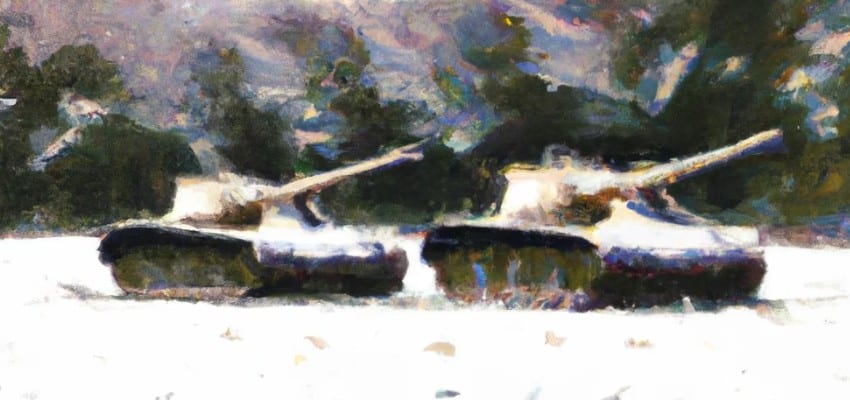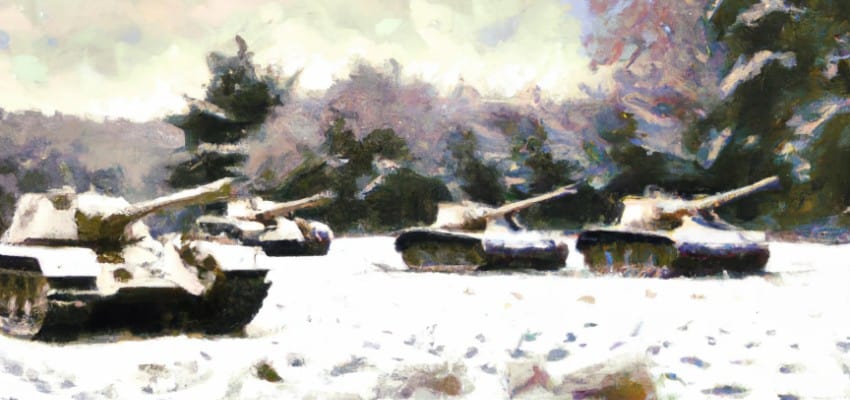|
|
Lost Victories? Russo-Ukrainian War Update (January 24 - 30, 2023)
Information - 93%
Insight - 92%
Relevance - 90%
Objectivity - 95%
Authority - 96%
93%
Excellent
A short percentage-based assessment of the qualitative benefit of the post highlighting the recent Ukraine conflict assessments in maps from the Institute for the Study of War.
Editor’s Note: The discipline of eDiscovery, which involves the identification, preservation, and analysis of electronic data, is increasingly being used in investigations and litigation relating to war crimes. In the case of the Russo-Ukrainian War, eDiscovery tools and techniques can be used to identify and collect electronic evidence of war crimes, such as emails, social media posts, and other digital communications that may provide valuable insights into the actions of individuals and organizations involved in the conflict. This evidence can then be used in investigations and legal proceedings to hold perpetrators of war crimes accountable for their actions. Additionally, eDiscovery can help to efficiently and effectively manage the vast amount of electronic evidence that may be relevant to war crimes cases, allowing investigators and legal teams to quickly and accurately analyze the data to identify key pieces of information. This weekly update may be useful for cybersecurity, information governance, and legal discovery professionals as they consider investigations and litigation resulting from war crimes committed during the war.
Background Note: One of the most accurate and detailed sources for ongoing updates on the Ukraine crisis is the Russian Offensive Campaign Assessment from the Institute for the Study of War. The Institute for the Study of War (ISW) is a 501(c)(3) organization and produces strictly non-partisan, non-ideological, fact-based research. ISW seeks to promote an informed understanding of war and military affairs through comprehensive, independent, and accessible open-source research and analysis. ISW’s research is made available to the general public, military practitioners, policymakers, and media members. Providing a daily synthesis of key events related to the Russian aggression against Ukraine, ISW updates may benefit investigators and litigators as they follow the business, information technology, and legal trends and trajectories impacted by and stemming from the current Russo-Ukrainian conflict.
Assessment and Maps*
Russo-Ukrainian Conflict Assessments – An Overview in Maps
- Institute for the Study of War (ISW), Russia Team
- Critical Threats Project (CTP), American Enterprise Institute
General Assessment Background Info
- ISW systematically publishes Russian campaign assessments that include maps highlighting the assessed control of terrain in Ukraine and main Russian maneuver axes.
- These maps augment daily synthetic products that cover key events related to renewed Russian aggression against Ukraine.
The Russian Offensive Campaign Assessments
- January 30, 2023
- By Karolina Hird, Grace Mappes, Layne Philipson, George Barros, Kitaneh Fitzpatrick, Nicole Wolkov, and Frederick W. Kagan
Key Development
- Western, Ukrainian, and Russian sources continue to indicate that Russia is preparing for an imminent offensive, supporting ISW’s assessment that an offensive in the coming months is the most likely course of action (MLCOA).
Key Takeaways
- Western, Ukrainian, and Russian sources continue to indicate that Russia is preparing for an imminent offensive, supporting ISW’s assessment that an offensive in the coming months is the most likely course of action (MLCOA).
- Iranian state media reported that Iran and Russia established direct financial communication channels between Iranian banks and more than 800 Russian banks on January 29.
- Russian forces continued ground attacks to regain lost positions west of Kreminna as Ukrainian forces conducted counteroffensive operations northwest of Svatove.
- Ukrainian forces continued to strike Russian force concentrations in rear areas in Luhansk Oblast.
- Russian forces continued to conduct ground attacks across the Donetsk Oblast front line.
- Russian forces continued to make marginal territorial gains near Bakhmut.
- Russian forces did not conduct any confirmed ground attacks in Zaporizhia Oblast.
- The Russian Ministry of Defense (MoD) continued measures to professionalize the Russian military as it faces continued backlash against these measures.
- Russian forces and occupation authorities continue to target Crimean Tatars in an effort to associate anti-Russia sentiment with extremist or terrorist activity.
- January 29, 2023
- By Frederick W. Kagan, Kimberly Kagan, Riley Bailey, Grace Mappes, Angela Howard, Mason Clark, Kateryna Stepanenko, and George Barros
Key Development
- Delays in the provision to Ukraine of Western long-range fires systems, advanced air defense systems, and tanks have limited Ukraine’s ability to take advantage of opportunities for larger counter-offensive operations presented by flaws and failures in Russian military operations.
Key Takeaways
- Russian sources claimed that Ukrainian forces continued counteroffensives in the vicinity of Kuzemivka (16km NW of Svatove).
- Ukrainian officials reported that Ukrainian forces continued to repel limited Russian counterattacks west and south of Kreminna.
- Wagner Group financier Yevgeny Prigozhin announced that Wagner forces seized Blahodatne (12km NE of Bakhmut) on January 29.
- Russian forces continued to conduct ground attacks in the Bakhmut and Donetsk City-Avdiivka areas.
- Ukrainian officials reported that Ukrainian forces repelled assaults near Pobieda (4km SE of Donetsk City) and Vuhledar. Russian sources claimed that fighting is ongoing to the west and east of Vuhledar.
- Russian sources did not report on any Russian ground attacks in Zaporizhia Oblast for the third consecutive day on January 29. Ukrainian forces conducted a HIMARS strike against a bridge in Svitlodolynske (20km NE of Melitopol).
- Russian forces continued to conduct routine fire against Kherson City and other settlements in the west bank of the Dnipro River. Kherson Oblast Administration Advisor Serhiy Khlan reported that Russian forces used incendiary munitions to fire on Beryslav.
- Russian authorities are continuing to set conditions for a second wave of mobilization. Head of the State Duma Committee on Defense Andrey Kartapolov stated on January 28 that the committee is reviewing over 20 laws regarding mobilization deferrals.
- The Ukrainian General Staff reiterated that it has not observed Russian forces in Belarus forming a strike group as of January 29.
- January 28, 2023
- By George Barros, Kateryna Stepanenko, Riley Bailey, Grace Mappes, Angela Howard, and Frederick W. Kagan
Key Development
- Conventional Russian forces are likely replacing exhausted Wagner Group forces to maintain the offensive in Bakhmut after the Wagner Group’s offensive in Bakhmut culminated with the capture of Soledar around January 12.
Key Takeaways
- Conventional Russian forces are likely replacing exhausted Wagner Group forces to maintain the offensive in Bakhmut after the Wagner Group’s offensive in Bakhmut culminated with the capture of Soledar around January 12.
- Russian forces are attempting to prevent Ukraine from regaining the initiative possibly ahead of a planned decisive Russian offensive in Donbas.
- Russian forces likely lack the combat power necessary to sustain more than one major offensive operation while fixing Ukrainian forces in western Donetsk and eastern Zaporizhia oblasts.
- The Russian military leadership may once again be planning an offensive operation based on erroneous assumptions about the Russian military’s capabilities
- The Russian military’s decreasing reliance on Wagner forces around Bakhmut is likely reducing Wagner Group financier Yevgeny Prigozhin’s influence.
- Russian forces reportedly continued limited counterattacks to regain lost positions along the Svatove-Kreminna line.
- Ukrainian forces continued to strike Russian rear areas in Luhansk Oblast.
- Russian forces continued offensive operations in the Bakhmut and Avdiivka-Donetsk City areas. Russian forces continued a localized offensive near Vuhledar in western Donetsk Oblast.
- Russian sources did not report any Russian ground attacks in Zaporizhia Oblast for the second consecutive day on January 28.
- Some Russian citizens continue limited efforts to sabotage Russian force generation efforts.
- Russian occupation officials continue to set conditions for the long-term forced deportation of Ukrainian children to Russia.
- January 27, 2023
- By Kateryna Stepanenko, Karolina Hird, Riley Bailey, George Barros, Layne Philipson, Nicole Wolkov, and Frederick W. Kagan
Key Development
- Kremlin insiders reportedly told Bloomberg that Russian President Vladimir Putin is preparing a new offensive to regain the initiative that may begin as early as February or March 2023.
Key Takeaways
- Kremlin insiders reportedly told Bloomberg that Russian President Vladimir Putin is preparing a new offensive to regain the initiative that may begin as early as February or March 2023.
- The Kremlin confirmed that Russian President Vladimir Putin is issuing preemptive pardons for convicts who serve in Russian operations in Ukraine.
- A visual investigation by a Russian opposition outlet confirmed that Russian authorities are deporting children from occupied Kherson Oblast to occupied Crimea.
- Russian officials denied reported explosions near the Zaporizhzhia Nuclear Power Plant (ZNPP) on January 26.
- The Russian military command is likely attempting to restrict mibloggers’ frontline coverage to regain control over the Russian information space ahead of the new offensive. These restrictions—if planned—are likely a part of the Chief of the Russian General Staff Army General Valery Gerasimov’s efforts to professionalize the Russian Armed Forces.
- Ukrainian forces continued counteroffensive operations near Kreminna on January 26 and January 27.
- Russian forces continued ground attacks around Bakhmut, on the western outskirts of Donetsk City, and in western Donetsk Oblast.
- Russian sources did not report that Russian forces continued localized offensive operations in Zaporizhia Oblast on January 27.
- Russian officials claimed that the conscription age will not change in the upcoming 2023 spring conscription cycle.
- Russian occupation authorities are continuing to intensify efforts to integrate occupied territories into the Russian legal and administrative structures.
- January 26, 2023
- By Kateryna Stepanenko, Karolina Hird, Riley Bailey, Grace Mappes, Layne Philipson, Nicole Wolkov, and Frederick W. Kagan
Key Development
- A recent altercation between Wagner Group financier Yevgeny Prigozhin and former Russian officer Igor Girkin is exposing a new domain for competition among Russian nationalist groups for political influence in Russia.
Key Takeaways
- Russian forces launched another massive series of missile and drone strikes across Ukraine on January 26.
- A recent altercation between Wagner Group financier Yevgeny Prigozhin and former Russian officer Igor Girkin is exposing a new domain for competition among Russian nationalist groups for political influence in Russia against the backdrop of Russian military failures in Ukraine.
- Russian President Vladimir Putin continued his campaign against critical and opposition voices by cracking down on several major opposition media outlets.
- The United States Treasury Department announced new sanctions targeting the Wagner Group’s global support network, likely in response to the Wagner Group’s renewed efforts to reinvigorate its operations outside of Ukraine.
- Russian sources claimed that Ukrainian forces relaunched counteroffensive operations near Kreminna.
- Russian forces continued ground attacks around Bakhmut, on the western outskirts of Donetsk City, and in the Vuhledar area.
- Ukrainian officials reported that Russian forces in Zaporizhia Oblast are not conducting offensive operations at the size or scale necessary for a full-scale offensive.
- Russian milbloggers claimed that Russian forces continued to conduct limited and localized ground attacks in Zaporizhia Oblast.
- The Wagner Group likely experienced significant losses in attritional offensive operations in eastern Ukraine over the past few months.
- Russian occupation officials are reportedly continuing to “nationalize” property and close places of worship belonging to the Ukrainian Evangelical Baptist Christian communities in occupied Zaporizhia Oblast in an effort to establish the Kremlin-affiliated Moscow Patriarchate Orthodox Church as the dominant faith in the region.
- January 25, 2023
- By Karolina Hird, Riley Bailey, Kateryna Stepanenko, Layne Philipson, Grace Mappes, and Frederick W. Kagan
Key Development
- Russian forces may be engaging in limited spoiling attacks across most of the frontline in Ukraine in order to disperse and distract Ukrainian forces and set conditions to launch a decisive offensive operation in Luhansk Oblast.
Key Takeaways
- Russian forces may be engaging in limited spoiling attacks across most of the frontline in Ukraine in order to disperse and distract Ukrainian fronts and launch a decisive offensive operation in Luhansk Oblast.
- The Russian military appears to be shifting its focus toward conventional forces deployed to Luhansk Oblast and away from the non-traditional force structure of the Wagner Group and its focus on Bakhmut.
- The Kremlin and Russian milbloggers attempted to downplay the Western provision of tanks to Ukraine, indicating that they likely find these systems threatening to Russian prospects.
- Russian forces claimed that Ukrainian forces conducted counteroffensive operations near Svatove as Russian forces continued limited ground attacks near Kreminna.
- Ukrainian forces have likely made advances around Kreminna.
- Ukrainian officials acknowledged that Ukrainian forces withdrew from Soledar.
- Russian forces continued offensive operations in the Bakhmut and Avdiivka-Donetsk City area. Russian forces reportedly continued localized offensive operations near Vuhledar.
- Russian forces continued to conduct small-scale ground attacks across the Zaporizhia Oblast front line, likely to attempt to fix Ukrainian forces in Zaporizhia Oblast.
- Russian milbloggers are divided over the veracity of Zaporizhia Oblast occupation official Vladimir Rogov’s ongoing, overblown information operation.
- The Kremlin is attempting to downplay new restrictions on crossing the Russian border, likely in an effort to contain panic within Russian society about a likely second mobilization wave.
- Russian President Vladimir Putin may be attempting to conduct another wave of mobilization discreetly out of concern for undermining his support among Russians.
- January 24, 2023
- By Karolina Hird, Riley Bailey, Grace Mappes, George Barros, and Frederick W. Kagan
Key Development
- A coalition of NATO member states reportedly will send Ukraine modern main battle tanks.
Key Takeaways
- A coalition of NATO member states reportedly will send Ukraine modern main battle tanks.
- Russian Chief of the General Staff Valery Gerasimov continued efforts to portray himself and the traditional Russian military command structure as the true defenders of Russia.
- Russian outlet RBK claimed on January 23 that Russian Defense Minister Sergei Shoigu appointed Colonel General Sergey Kuzovlev as the Southern Military District (SMD) commander and Lieutenant General Yevgeny Nikiforov as the Western Military District (WMD) commander.
- Russian forces continued limited counterattacks along the Svatove-Kreminna line and Ukrainian forces reportedly continued counteroffensive operations near Kreminna.
- Russian forces continued to conduct ground attacks in the Bakhmut and Avdiivka-Donetsk City area. Russian forces made marginal territorial gains near Bakhmut.
- Russian sources claimed, likely to distract from the lack of progress in Bakhmut, that Russian forces launched an offensive around Vuhledar.
- Russian forces likely continued to conduct limited and localized ground attacks in Zaporizhia Oblast but likely did not make territorial gains, further undermining Zaporizhia Oblast occupation official Vladimir Rogov’s prior territorial claims.
- Ukrainian special forces conducted a raid across the Dnipro River in Kherson Oblast on January 23-24.
- Russian authorities are likely continuing efforts to mobilize ethnic minorities to fight in Ukraine.
- Russia’s defense industrial base (DIB) is reportedly increasing the production of drones and loitering munitions.
- Ukrainian partisans targeted a member of the Zaporizhia occupation administration.
We do not report in detail on Russian war crimes because those activities are well-covered in Western media and do not directly affect the military operations we are assessing and forecasting. We will continue to evaluate and report on the effects of these criminal activities on the Ukrainian military and population and specifically on combat in Ukrainian urban areas. We utterly condemn these Russian violations of the laws of armed conflict, Geneva Conventions, and humanity even though we do not describe them in these reports.
Chronology of Maps from January 24 -30, 2023 – Mouseover to Scroll
Ukraine Conflict Maps - 012423 - 013023See the Institute for the Study of War Interactive Map of the Russian Invasion
Read the latest Ukraine Conflict updates from the Institute for the Study of War
* Shared with direct express permission from the Institute for the Study of War (ISW).
About the Institute for the Study of War Research Methodology
ISW’s research methodology relies on both primary and secondary sources, enabling researchers to develop a comprehensive understanding of the situation on the ground. In order to analyze military and political developments in any given area, ISW’s research analysts must wholly understand the systems of enemy and friendly forces. They must also understand the population demographics, physical terrain, politics, and history of that area. This lays the analytical foundation for understanding the reasons for particular developments and fulfilling their assigned research objectives. ISW analysts also spend time in places like Iraq, Afghanistan, and elsewhere in order to gain a better understanding of the security and political situation and to evaluate the implementation of current strategies and policies. Our researchers compile data and analyze trends, producing a granular analysis of developments in areas of research, producing an accurate, high-resolution, timely, and thorough picture of the situation. ISW’s research methodology guarantees its success and commitment to improving the nation’s ability to execute military operations, achieve strategic objectives, and respond to emerging problems that may require the use of American military power.
About the Institute for the Study of War
The Institute for the Study of War advances an informed understanding of military affairs through reliable research, trusted analysis, and innovative education. We are committed to improving the nation’s ability to execute military operations and respond to emerging threats in order to achieve U.S. strategic objectives. ISW is a non-partisan, non-profit, public policy research organization.
Learn more, get involved, and contribute today.
Additional Reading
- [Annual Update] International Cyber Law in Practice: Interactive Toolkit
- Data Embassies: Sovereignty, Security, and Continuity for Nation-States
Source: ComplexDiscovery
























